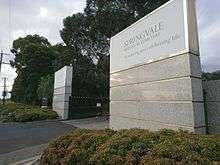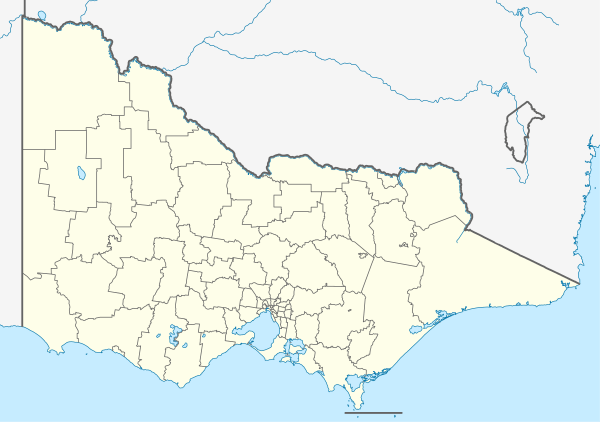Springvale Botanical Cemetery
The Springvale Botanical Cemetery is the largest crematorium and memorial park in Victoria, Australia. It is located in Springvale, in the south-eastern suburbs of Melbourne.
 Springvale Botanical Cemetery's Princes Highway entrance. | |
 | |
| Details | |
|---|---|
| Established | 1901 |
| Location | |
| Country | Australia |
| Coordinates | 37°56′33″S 145°10′32″E |
| Website | Springvale Botanical Cemetery |
| Find a Grave | Springvale Botanical Cemetery |
History
Originally known as The Necropolis Springvale, the cemetery commenced operations in 1901.[1] Between 1904 and 1952 it was served by its own railway branch line and station, by which coffins, passengers and staff were conveyed to the cemetery.[2][3] The first cremation took place at Springvale in April 1905.[4] In 2007 Springvale conducted over 2000 burials and 6000 cremations.
In 2006, the cemetery was renamed the Springvale Botanical Cemetery to reflect its increasing botanical significance, which includes original plantings of two bunya-bunya pines, palms and gums.[3] It is now administered by the Southern Metropolitan Cemeteries Trust (SMCT), which manages nine cemeteries in all, including the Melbourne General Cemetery, St Kilda Cemetery and Dandenong Community Cemetery.[5]
Notable Interments
- Frank Bladin (1898–1978), RAAF commander
- Scobie Breasley (1914–2006), champion jockey
- A.R. Chisholm (1888–1981), French language scholar
- Zelman Cowen (1919–2011), Governor-General
- Cyril Clowes (1892–1968), soldier
- Erle Cox (1873–1950), author
- Frank Crean (1916–2008), Deputy Prime Minister
- Bernard Cronin (1884–1968), author
- Jack Dyer (1913–2003), footballer
- James Fowler (1863–1940), politician, author
- Cathy Godbold (1974–2018), actress
- Robert Grieve VC (1889–1957), soldier
- Walter Hume (1873–1943), inventor, concrete pipe developer
- Richard Kelliher VC (1910–1963), soldier
- Jack Little (1908–1986), media personality
- Rosemary Margan (1937–2017), radio and television personality
- John McEwen (1900–1980), Prime Minister
- Bess Norriss (1878–1939), artist
- Horace Petty (1904–1982), politician
- Dorothy Porter (1954–2008), poet
- John Ryan VC (1890–1941), soldier
- Reginald Sholl (1902–1988), Supreme Court justice, diplomat
- Billy Snedden (1926–1987), politician
- Charles Tait (1868–1933), film maker, theatrical entrepreneur
- Bud Tingwell (1923–2009), actor
- Fannie Eleanor Williams (1884–1963), scientist
- Kath Williams (1895–1975), trade unionist, equal pay campaigner
- Tommy Woodcock (1905–1985), Phar Lap's handler
- Bill Woodfull (1897–1965), cricketer
- Henry Wynter (1886–1945), soldier
War graves
The Botanical Cemetery contains the war graves of 146 Commonwealth service personnel, nearly 50 from World War I and nearly 100 from World War II.[6] In addition the Commonwealth War Graves Commission (CWGC) also commemorates 67 Commonwealth service personnel cremated at Springvale Crematorium whose ashes remain here.[7]
Springvale War Cemetery
Within two acres of the Botanical Cemetery, beyond the crematorium, lies the CWGC's Springvale War Cemetery, created in World War II, where there are buried 607 Commonwealth service personnel and 4 Dutch personnel. It contains a Cross of Sacrifice unveiled in 1948.[8] In the form of bronze plaques, on the rear wall of the shelter behind the Cross, is the Victoria Cremation Memorial to 75 Commonwealth service personnel who were cremated within the State of Victoria but whose ashes were disposed of where a memorial could not be sited.[9]
See also
References
- "About our Cemetery". Southern Metropolitan Cemeteries Trust. Retrieved 26 August 2018.
- Springvale Cemetery Railway, Mitchell, Frank, Green Over Red – Box Hill, Vic. March, 1968 pp. 5-6
- Gadd, Denise (15 February 2012). "New life for the city of the dead". The Age. Retrieved 26 August 2018.
- "Cremation". The Argus. Melbourne: National Library of Australia. 14 April 1905. p. 5. Retrieved 11 January 2015.
- "Our Cemeteries". Southern Metropolitan Cemeteries Trust. Retrieved 26 August 2018.
- SPRINGVALE BOTANICAL CEMETERY – CWGC Cemetery Report.
- cwgc.org/find-a-cemetery/cemetery/2090472/springvale-crematorium-melbourne/
- cwgc.org/find-a-cemetery/cemetery/2082901/springvale-war-cemetery/
- cwgc.org/find-a-cemetery/cemetery/2082902/victoria-cremation-memorial
Further reading
- Chambers, D (2001) City of the Dead: A History of The Necropolis, Springvale, Flemington Vic: Hyland House ISBN 1-86447-020-8
External links
- Springvale Botanical Cemetery website
- Springvale Botanical Cemetery – Billion Graves